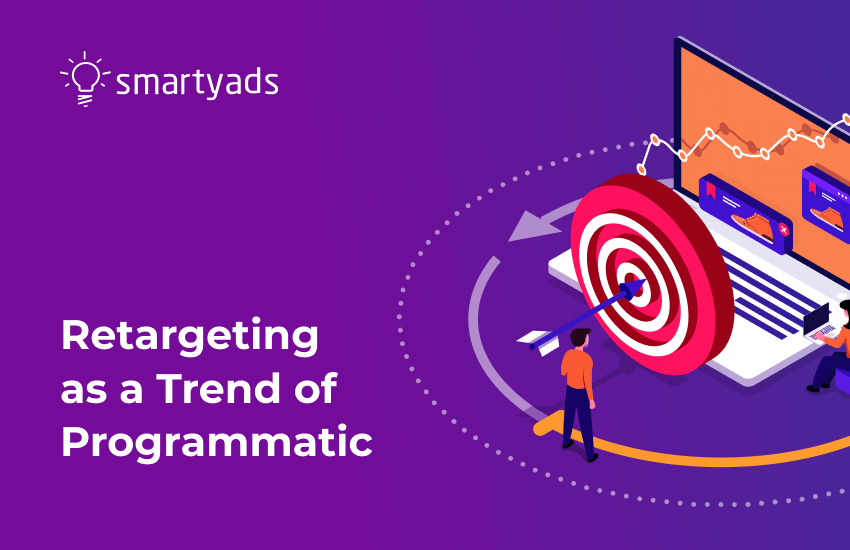In the fast-evolving digital world, new products and services appear every day. Various ad networks and digital marketers are trying to make their brands stand out in a competitive market. Thus, new tools accelerating media advertising and enhancing brand awareness are in huge demand.
Many marketing techniques promise to boost engagement, clicks, and conversions. Retargeting has attracted the attention of many marketers. It’s a groundbreaking tendency that can greatly impact your marketing strategy, unlock new business opportunities, and fully transform your digital marketing and advertising efforts.
In this article, you will learn the fundamentals of retargeting advertising: what is digital retargeting meaning, why it matters, and what are the best practices of retargeting in marketing? Let’s get started!

What is retargeting in digital marketing?
Retargeting is an approach that targets users who have previously interacted with a website or social media or engaged with content but didn’t complete the desired action, such as making a purchase, filling out a form, etc.
This is a tool for ad agencies and digital marketers to conduct their brand strategies in a way that allows them to enhance user targeting and reach the highest level of conversion. Retargeting focuses only on those who are familiar with your brand or have recently shown interest in your products or services.
Retargeting in digital marketing is an excellent chance to convert users who didn’t become customers during the first interaction with a business by showing them relevant ads to bring them back and complete the conversion process. This strategy increases the likelihood of conversions as you re-engage with highly interested prospects.
Brand managers make their ads relevant to the users to create a meaningful customer experience. According to the latest stats, 70% of marketers prefer retargeting to increase brand awareness, whereas 60% use it to tighten social engagement (spending 10–50% of their entire online ad budget on it).
According to stats, retargeted shoppers are 70% more likely to convert, and retargeting campaigns can increase conversion by up to 150%. Today, many tech vendors offer full-stack solutions for advertisers and publishers. For that reason, retargeting is becoming essential, a necessity in the future of digital marketing. They have proven to be a powerful tool for converting bounced traffic into potential consumers.
In turn, there’s a good chance that users will complete your call to action — they might want to return to your website, finish a purchase, or use any service your brand offers.
How does retargeting work?
Before you decide to make retargeting a part of your robust content strategy, let’s dive a bit deeper and answer the question: “How do retargeting ads work?” Retargeting is a cookie-based technology with a piece of JavaScript code built into a website. Once a new visitor comes, that piece of code drops an unnoticeable browser cookie to let a special retargeting marker know at what time these ads should be placed on a website.
To be specific, retargeted ads are “chasing” the prior website users on whatever web pages or web devices they are in (as well as on social media platforms). Retargeting ads remind people of your products or services, no matter where they are. Hence, the chances of revisiting your website are increased.
However, there are several effective types of retargeting marketing, which could be displayed to users in more than one form. For example, on other web pages after leaving your website, such as Facebook ads, they might be shown to new users who were recently searching for keywords somehow related to your business expertise (which is called “search retargeting”). Your ads can also be displayed in email newsletters.
Retargeting vs remarketing: what is the difference?
To differentiate remarketing vs retargeting you need to understand the basic principles of each of these methods. While retargeting is commonly based on cookies, remarketing is used to collect users’ data to target them with personalized campaigns through email marketing. One of the reasons why email campaigns work is that this type of communication channel remains one of the most effective to engage better with customers.
Well, how does remarketing work? Once the user has visited a website, they’re automatically added to what is called a “remarketing list.” Then, personalized ad campaigns are created specifically for people on that list. So, the ads are shown only to potential consumers.
Even though retargeting and remarketing in digital marketing differ from each other, they are sticking to a single goal — to make visitors want to return to your website. However, they both will be working better in tandem — as a powerful tactic to re-engage visitors. However, decide beforehand which one should be prioritized.
What are the benefits of retargeting ads?
Increased user awareness
After leaving your website, people will remember your brand better through enhanced visibility. Users are constantly noticing retargeted ads that are shown to them in an increased amount of time. The result? Your brand becomes memorable.
Cost-effectiveness
Retargeted marketing has proven to be a cost-effective tool that converts only those who were interested in your products or services earlier. These ads are tightly focused on consumers who are ready to take action on your website. Hence, you won’t spend ad money on worthless digital campaigns. The result? More purchases.
Long-term campaigns
Ad networks and advertisers can gather more insights when remarketing campaigns are running long-term. In such a way, your brand is recognizable, the costs are saved, and the profits are growing. All that’s left is to continue opening up new interesting prospects. The result? Increased conversions.
Instrument for promoting new or popular products
You can leverage the power of retargeting for promoting new or hight demanding products or services. It enables marketers to target users who have previously engaged with their content or website. In this case, retargeting ads maintain the high visibility of your offerings so more interested people can pay attention, which increases the likelihood of conversions. This approach can be applicable to existing products or when launching new ones.
Engaging prospects throughout every stage of their journey
Retargeting advertising is a great tool to reach prospects at every stage of their journey. As they move through the buying process, these ads keep your company on top of mind. As they target users who have already demonstrated interest in your products or services, it’s a perfect opportunity to remind them to take action such as completing a purchase, signing up, or reading more.
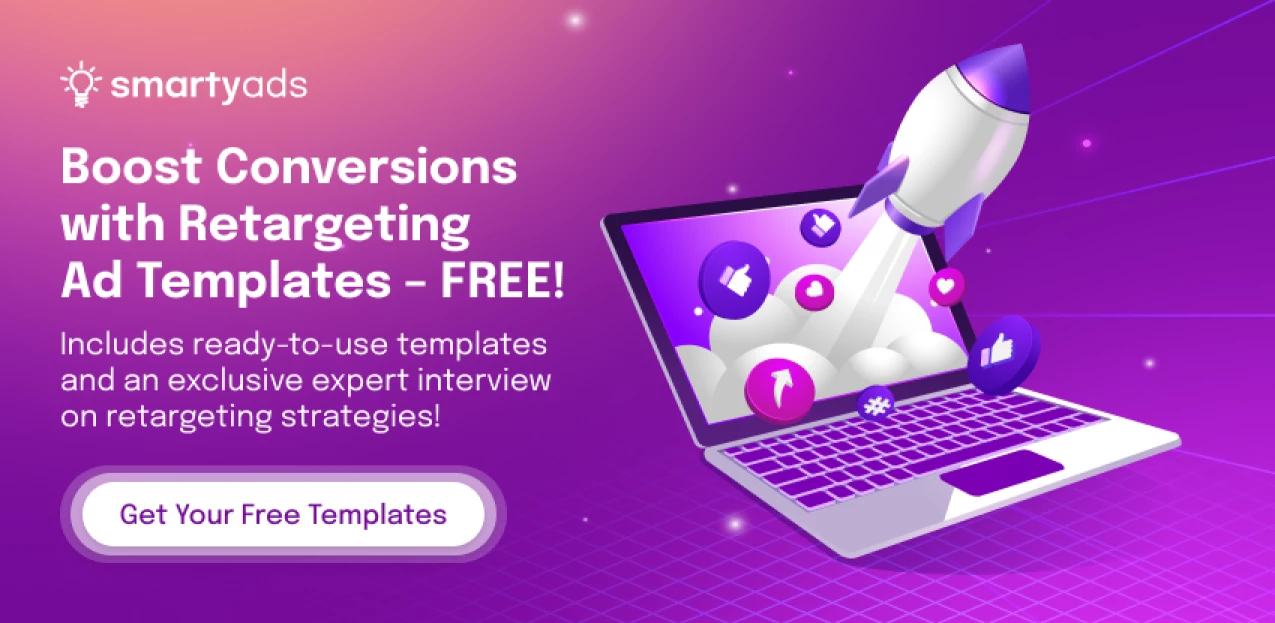
What are the different types of retargeting campaigns?
Site retargeting
Site retargeting is a perfect solution to target users who have visited your website but didn’t complete a desired action, such as making a purchase or signing up for a newsletter. These ads are used as a reminder of your products or services, encouraging visitors to return and complete actions.
Search retargeting
The search retargeting ads aim at users based on their search engine queries. You can do this by analyzing the keywords of your target audience first. The next step is to serve ads to people who are searching for products or services similar to yours. This tactic gives you a pretty high chance of successful conversions.
Social media retargeting
You can deliver your ads through social media platforms like Facebook, Instagram, Twitter, or LinkedIn to users who have interacted with your brand or website. This type of retargeting helps your brand stay visible on social media, where people are most active and highly engaged.
Email retargeting
Email retargeting ads can be served to users who have opened emails from your company but haven’t taken any further action. By effectively combining both email marketing and retargeting ads, you can re-engage potential clients and drive them back to your website to complete the intended action.

Challenges and solutions in retargeting
Ad fatigue
One of the main challenges associated with retargeting is ad fatigue. Sometimes, advertisers bombard users with their advertising campaigns making them feel irritated and annoyed. At some point, users will simply ignore your ads thus cutting the campaign's effectiveness.
Solution:
Most DSPs offer frequency capping features that will enable you to protect users from seeing the same ad all the time and regulate how often they will see your ad. In addition, you can access a wide range of ad formats to deliver your creatives and messages in the most effective yet diverse way without creating annoyance and ad blindness.
Privacy concerns
Constantly evolving privacy regulations like GDPR and CCPA have significantly impacted retargeting digital marketing. Therefore, it’s highly recommended to comply with these regulations to make sure you do it right. In addition, it’s a way to foster loyal relationships with potential customers.
Solution:
Businesses should establish a transparent consent policy and obtain the user’s consent before collecting, storing, and using their data. This privacy approach will easily build trust and ensure your adherence to all legal requirements.
Lack of segmentation
Retargeting certainly doesn’t like a one-size-fits-all approach. Some marketers and advertisers underestimate the value of proper segmentation and launch their campaigns for one big audience expecting to see brilliant results. Spoiler: it doesn’t work like this. Usually, they end up showing irrelevant ads to users, wasting budget, and missing opportunities.
Solution:
When creating your future retargeting campaign, invest time in segmenting your audience based on multiple factors such as behavior, interests, demographics, etc. depending on your business goals. Also, come up with tailored messages for each audience segment to make sure your ads resonate and create impact.
Ad Blockers
Unfortunately, the increasing use of ad blockers poses a really big challenge for retargeting efforts. Due to this, more and more ads simply do not reach the intended audience.
Solution:
There is not so much we can do about it, however, it’s still possible to mitigate this challenge. My advice is to focus on creating quality non-intrusive ads that give value to the user and enhance their experience. Explore alternative ad formats, such as native ads, video ads, rich media, or sponsored content, which are less likely to be blocked and are very effective and engaging.
Top platforms for running your retargeting ads
After each platform, add a photo of an example advertisement
SmartyAds
SmartyAds is a great platform to easily set up, launch, and manage your successful retargeting ad campaigns. Our platform offers advanced programmatic solutions that help you reach audiences across various channels, including mobile, desktop, CTV, and beyond.
Read about mobile ad retargeting here.
With SmartyAds innovative features (frequency capping real-time analytics, dynamic CPM, and more)and simple interface, you can create and optimize personalized retargeting campaigns that drive conversions.
Feel free to review the full list of cases by SmartyAds to evaluate our expertise and see how we help our clients achieve their advertising goals through innovative DSP and SSP.
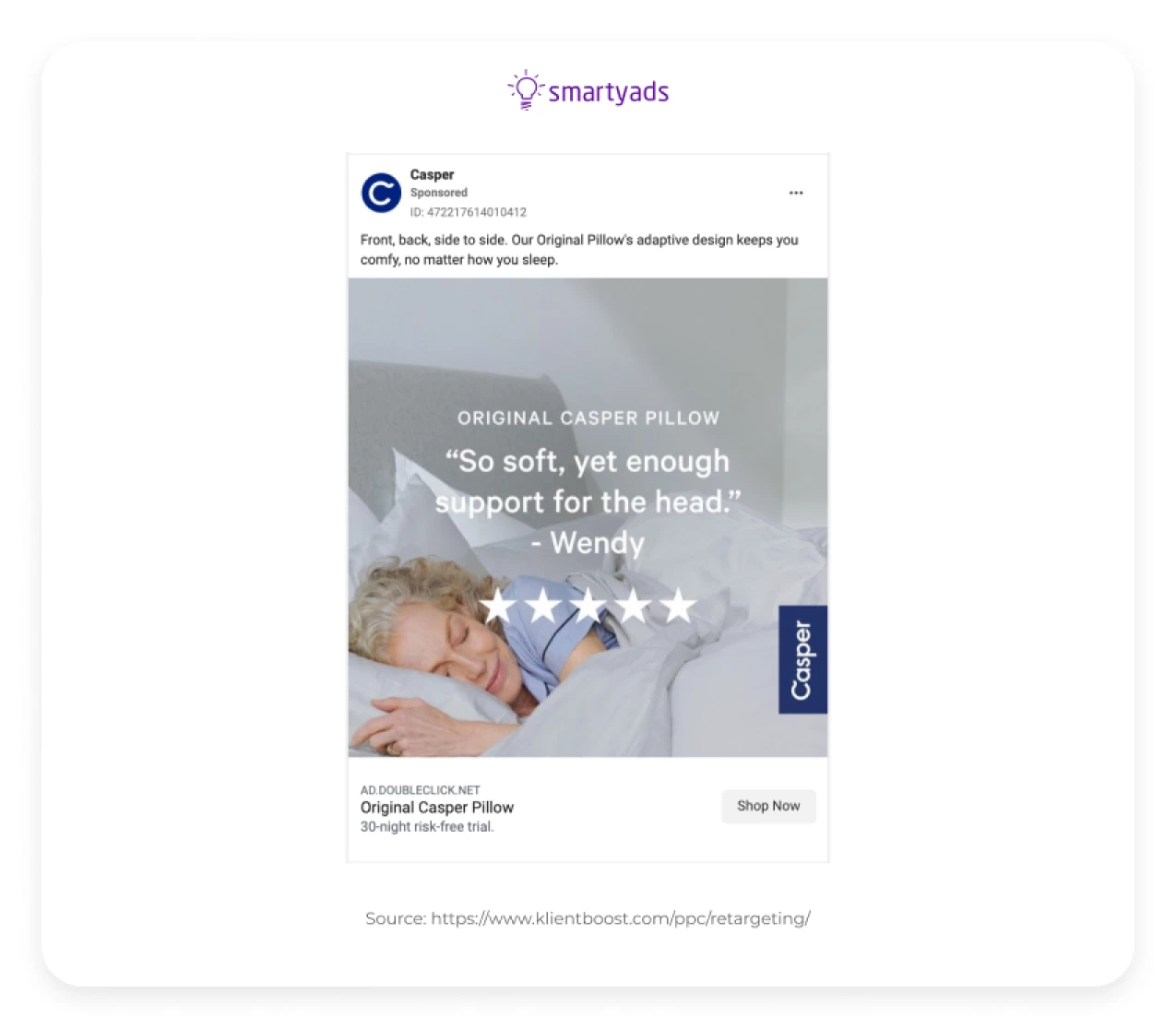
AdClarety
This tool enables you to effectively reconnect with your prospects and make them complete their customer journey with data-driven features and advanced targeting. It also allows marketers to discover the most profitable platforms to select the most convenient and effective channel for retargeting campaigns.
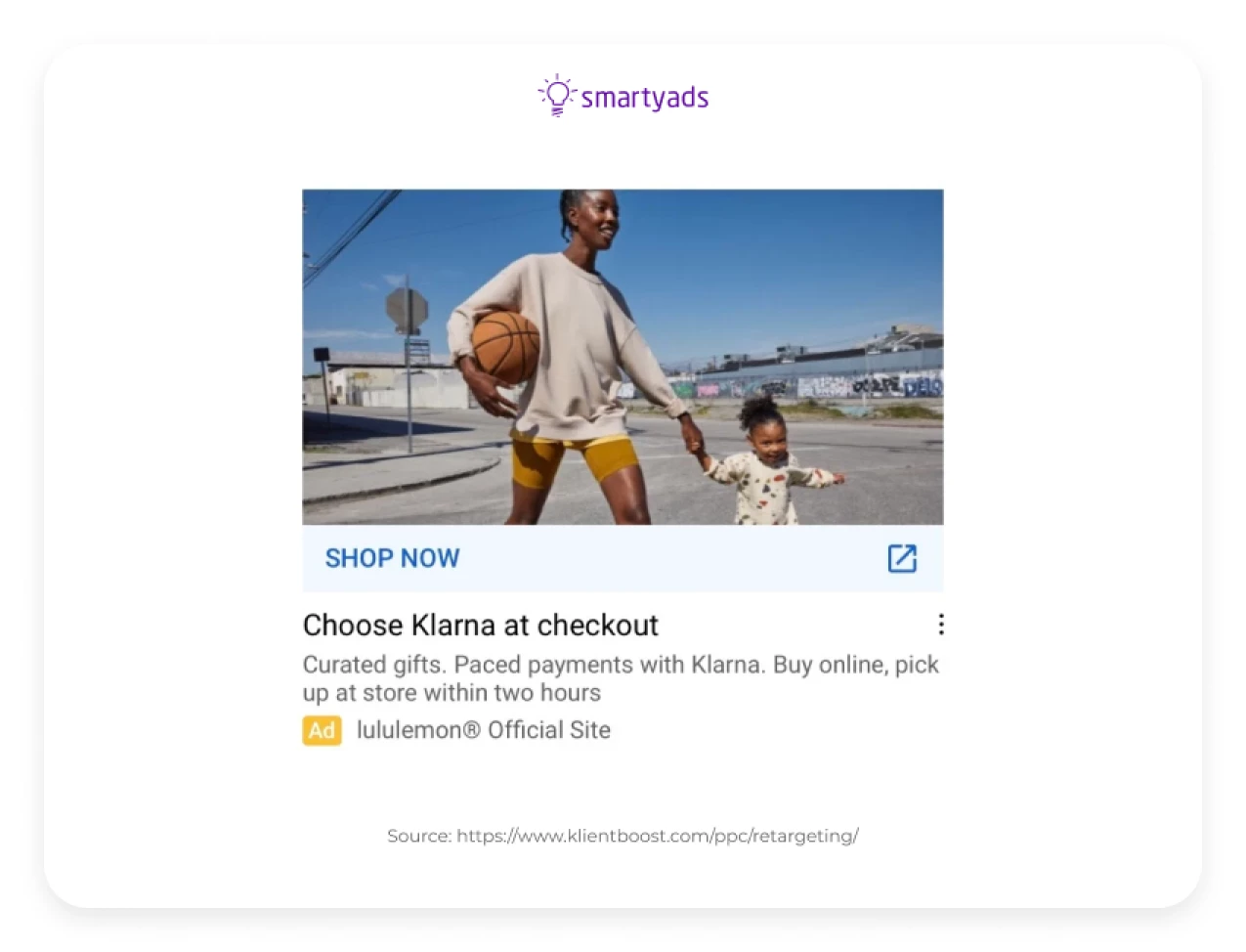
One2Target
This platform can also be used for delivering retargeting campaigns. They offer access to detailed insights on the preferred market audience to tailor the campaign based on the users’ preferences and behavior. Easily reach your desired audience with precision across multiple channels increasing the likelihood of conversions.
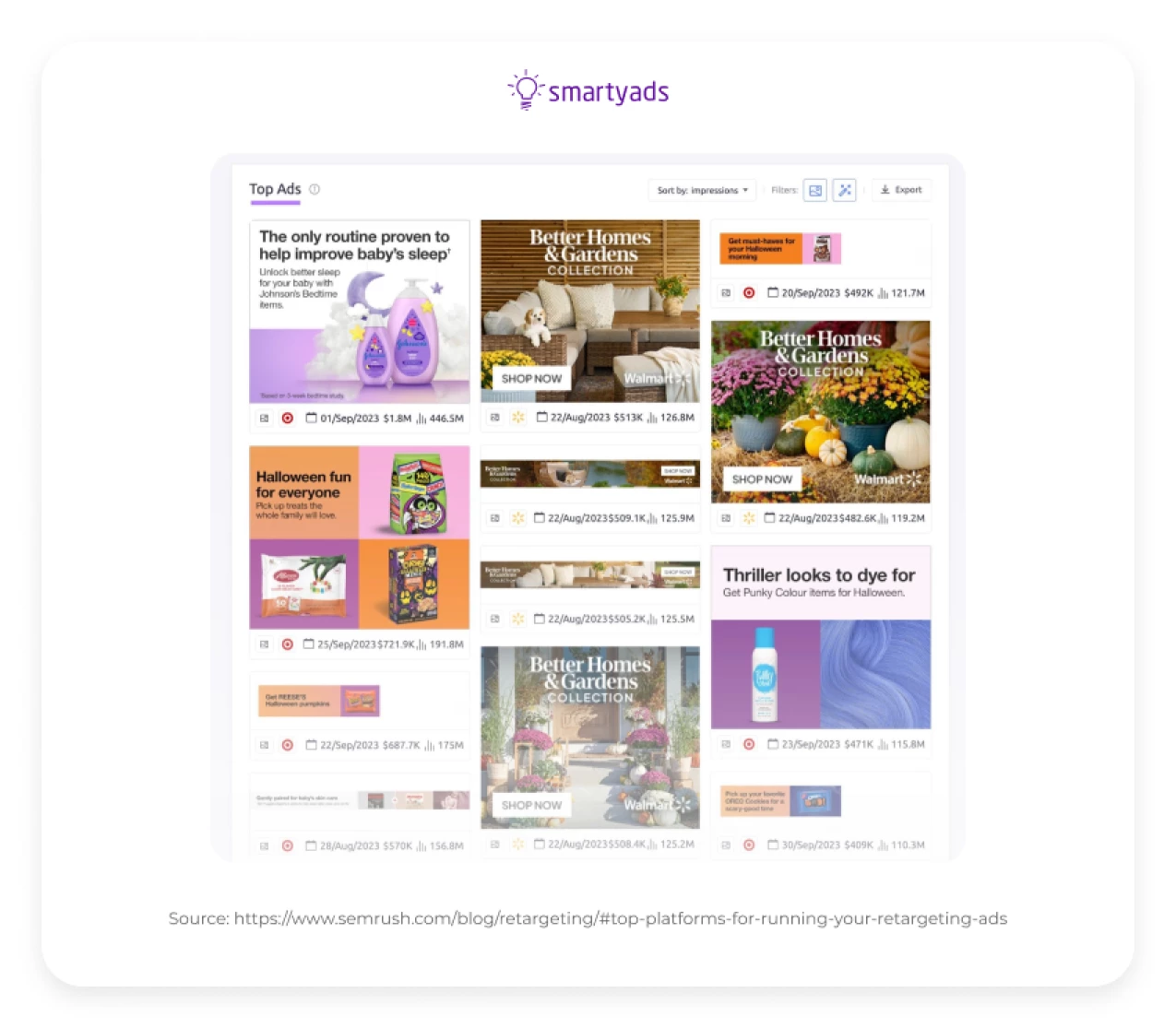
Some of the best practices of marketing retargeting
Before you get started with retargeting services in advertising, follow these principles to run a smarter campaign.
Exclude those who are already converted
In doing so, you won’t disturb people who are already familiar with your brand or have taken any action on a website. That means your time and efforts are saved!
Use a frequency cap
To make sense of your ad campaigns, try to limit the amount of time your ads are shown all over the web and be strategic in ad planning and scheduling. That means your customers are no longer overwhelmed with an enormous amount of ads.
Ensure contextual targeting
Consider all contextual factors, such as age, gender, demographic information, and other essential data. Such an algorithm will help digital marketers to determine what types of ads their consumers are interested in and serve them accordingly. That means you will be placing your ads at the right time and to the right people.
Select one person to run retargeting campaigns
To figure out which campaigns are working better than the others, choose one specific marketer who will be responsible for running media retargeting campaigns. It will be far more beneficial and easier to analyze its ups and downs. That means more advanced analytics for future campaigns.
Optimize banner ads
Never underestimate the power of banner ads that you can run on the demand-side platform. The amount of content you place on ads matters. There should be a wise correlation between the space and the information on it. Moreover, take into consideration the colors, design, and how clickable your call-to-action buttons are.
Also, make your creatives as lightweight as possible to facilitate smooth unit rendering on the ad server. All these aspects determine whether your ads will drive success. That means your ads are easy to read and well-branded.
It’s time to forget about manual ad placing
Even if your ad campaigns are perfectly designed, they have to be shown to the target audience in real-time and function in accordance with your business objectives. One of the most effective ways to increase your conversion rates is to find a tool that meets your specific brand needs. The whole programmatic ecosystem consists of demand-side platforms (DSPs), supply-side platforms (SSPs), ad exchanges, etc.
The top Demand-side platforms offer unique, cutting-edge tech solutions to build comprehensive retargeting marketing campaigns, engage more consumers, and attain a higher ROI. DPSs like SmartyAds allow forecasting of which impression to bid on and help determine its value.
Our Demand-side platform provides media-buying capabilities to multiple advertisers and ad networks to easily transform a brand story into an ad creative campaign across various channels and devices with a DSP retargeting feature.
Final word
As you can see, retargeting is a very powerful instrument in advertising and marketing that will enhance your overall digital strategy and enable you to achieve business goals with ease. By discovering what is retargeting in marketing and what are the best practices associated with this marketing tool you will be able to raise brand awareness, boost conversions, and reconnect with previous clients or visitors. Personalized ad placements and advanced targeting will help businesses to guide potential customers to their websites.
In the ever-evolving digital world, launching and optimizing retargeting campaigns will remain crucial for achieving sustained business growth and maximizing ROI in the competitive online landscape.
Don’t miss out on a chance to make your ad publishing process easier and more effective — with less ad spend yet much value due to the automated superpowers that SmartyAds DSP provides. To find out more about our innovative solutions, contact our digital experts!
Let’s get started with an innovative DSP to build a winning digital strategy!

